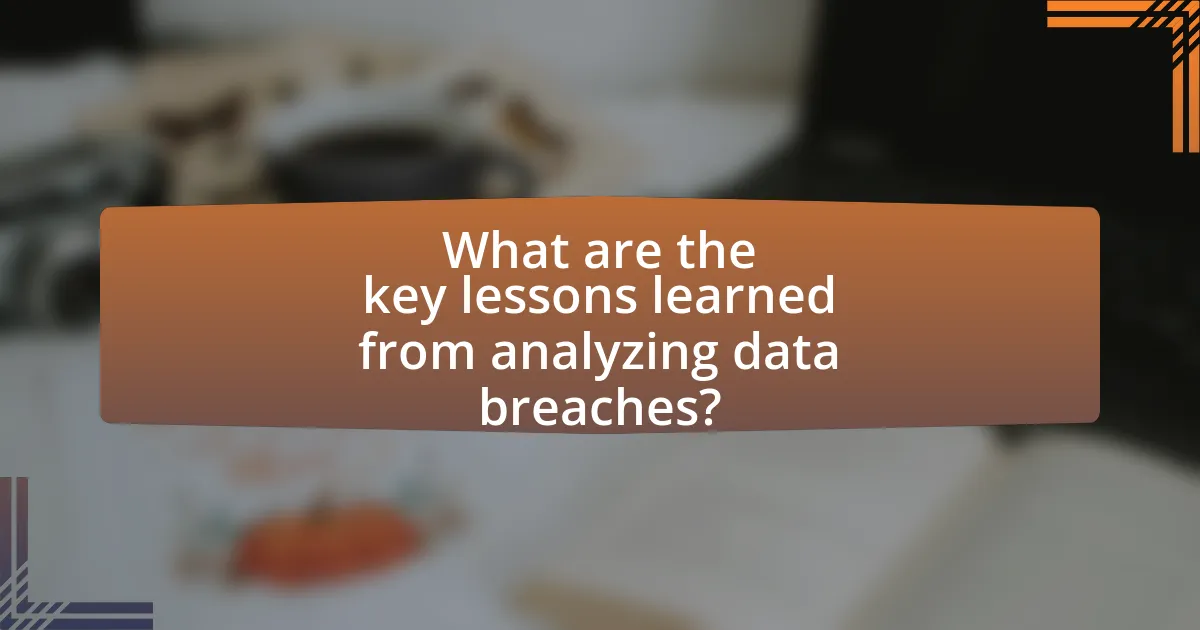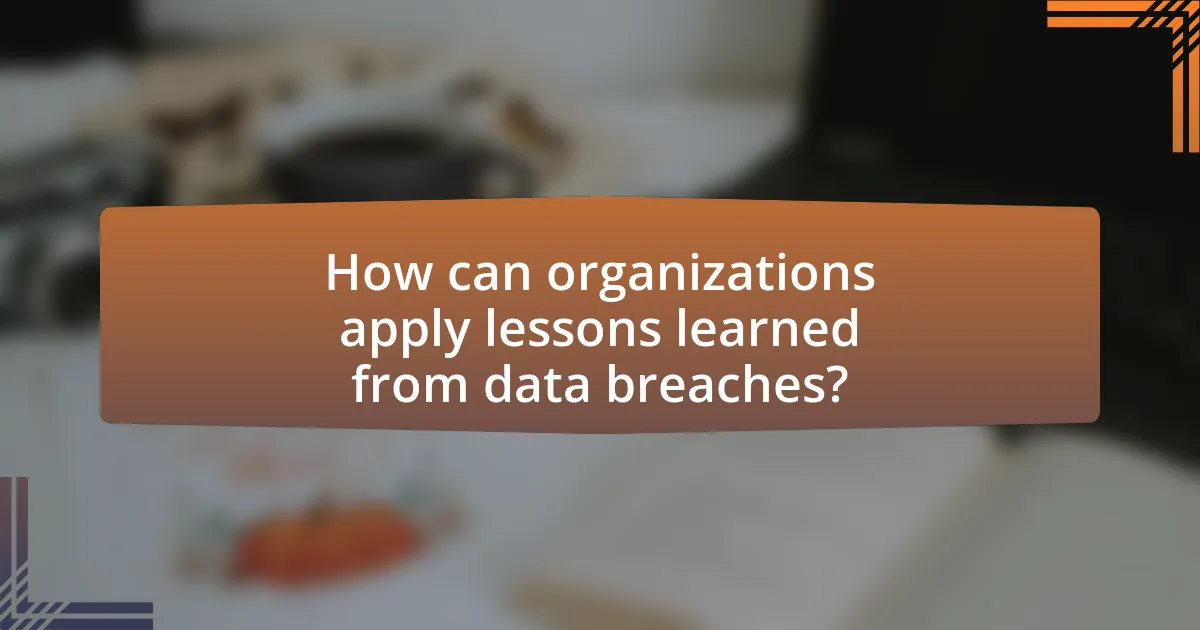Real-world data breaches involve unauthorized access to sensitive information, leading to significant consequences for individuals and organizations. This article analyzes the causes and implications of data breaches across various industries, highlighting the role of human error, cyberattacks, and system vulnerabilities. It emphasizes the importance of analyzing past breaches to improve security measures, enhance incident response plans, and foster a culture of security awareness. Key lessons learned include the necessity of proactive security strategies, employee training, and effective communication during incident response efforts. The article provides practical tips for organizations to strengthen their defenses against future breaches and improve their overall security posture.

What are Real-World Data Breaches?
Real-world data breaches are incidents where unauthorized individuals gain access to sensitive, protected, or confidential data, often resulting in the exposure of personal information, financial records, or proprietary business data. These breaches can occur through various methods, including hacking, phishing, or physical theft, and they have significant implications for individuals and organizations, including financial loss, reputational damage, and legal consequences. For instance, the 2017 Equifax breach exposed the personal information of approximately 147 million people, highlighting the scale and impact of such incidents.
How do data breaches occur in various industries?
Data breaches occur in various industries primarily through cyberattacks, human error, and inadequate security measures. In the healthcare sector, for example, breaches often result from phishing attacks targeting employees, leading to unauthorized access to sensitive patient data. According to the U.S. Department of Health and Human Services, over 40 million patient records were compromised in 2021 alone, highlighting the vulnerability of healthcare systems.
In the financial industry, data breaches frequently arise from malware attacks and insider threats. A report by Verizon indicated that 25% of breaches in the financial sector involved insider misuse, emphasizing the need for robust access controls and monitoring. Retail businesses also face significant risks, often due to point-of-sale (POS) system vulnerabilities. The 2013 Target breach, which exposed 40 million credit card numbers, exemplifies how attackers exploit weak security in payment systems.
Additionally, manufacturing and technology sectors experience breaches through supply chain vulnerabilities, where third-party vendors may lack adequate security protocols. The SolarWinds attack in 2020 demonstrated how a compromised software update could lead to widespread data exposure across multiple industries.
Overall, data breaches are a multifaceted issue, with each industry facing unique challenges that necessitate tailored security strategies to mitigate risks effectively.
What are the common causes of data breaches?
Common causes of data breaches include human error, malicious attacks, and system vulnerabilities. Human error, such as sending sensitive information to the wrong recipient or failing to secure devices, accounts for approximately 30% of breaches, according to the 2021 Verizon Data Breach Investigations Report. Malicious attacks, including phishing and ransomware, are responsible for a significant portion of breaches, with phishing alone accounting for 36% of incidents in the same report. Additionally, system vulnerabilities, such as outdated software or unpatched systems, create entry points for attackers, contributing to around 22% of breaches. These statistics highlight the multifaceted nature of data breaches and the importance of addressing each cause to enhance security measures.
How do human errors contribute to data breaches?
Human errors significantly contribute to data breaches by creating vulnerabilities that can be exploited by malicious actors. For instance, a study by the Ponemon Institute found that 23% of data breaches are caused by human mistakes, such as sending sensitive information to the wrong recipient or failing to secure devices. These errors often stem from inadequate training, lack of awareness about security protocols, or simple negligence, which can lead to unauthorized access to sensitive data. Furthermore, the Verizon 2021 Data Breach Investigations Report indicated that 85% of breaches involved a human element, highlighting the critical role that human errors play in compromising data security.
Why is it important to analyze data breaches?
Analyzing data breaches is crucial for understanding vulnerabilities and preventing future incidents. By examining the specifics of a breach, organizations can identify weaknesses in their security protocols, assess the impact on affected individuals, and implement targeted measures to enhance their defenses. For instance, the 2017 Equifax breach, which exposed the personal information of approximately 147 million people, highlighted the need for improved patch management and incident response strategies. This analysis not only aids in compliance with regulations but also fosters trust with customers by demonstrating a commitment to data protection.
What insights can be gained from studying past breaches?
Studying past breaches reveals critical insights into vulnerabilities, attack vectors, and response effectiveness. Analyzing historical data breaches, such as the Equifax breach in 2017, which exposed the personal information of 147 million people due to unpatched software vulnerabilities, highlights the importance of timely software updates and vulnerability management. Furthermore, the Target breach in 2013, which resulted from compromised vendor credentials, underscores the necessity of securing third-party access and implementing robust authentication measures. These examples demonstrate that understanding the circumstances and consequences of previous breaches can inform better security practices, enhance incident response strategies, and ultimately reduce the likelihood of future incidents.
How can data breach analysis improve security measures?
Data breach analysis can significantly improve security measures by identifying vulnerabilities and weaknesses in existing systems. By examining the methods and techniques used in past breaches, organizations can implement targeted strategies to fortify their defenses. For instance, a study by Verizon in its 2021 Data Breach Investigations Report revealed that 85% of breaches involved a human element, highlighting the need for enhanced employee training and awareness programs. Additionally, analyzing breach patterns allows organizations to prioritize security investments based on the most common threats, thereby optimizing resource allocation. This proactive approach not only mitigates risks but also fosters a culture of continuous improvement in security practices.

What are the key lessons learned from analyzing data breaches?
Key lessons learned from analyzing data breaches include the importance of proactive security measures, the necessity of employee training, and the value of incident response planning. Proactive security measures, such as regular software updates and vulnerability assessments, significantly reduce the risk of breaches; for instance, organizations that implement these practices experience 50% fewer incidents. Employee training is crucial, as human error accounts for approximately 90% of data breaches, highlighting the need for ongoing education on security protocols. Additionally, having a well-defined incident response plan enables organizations to respond swiftly and effectively, minimizing damage; studies show that companies with such plans can reduce recovery time by up to 30%.
How can organizations enhance their incident response plans?
Organizations can enhance their incident response plans by conducting regular training and simulations for their response teams. These exercises help identify gaps in the plan and improve team coordination during actual incidents. According to a study by the Ponemon Institute, organizations that conduct regular incident response exercises experience a 30% reduction in the time taken to contain breaches compared to those that do not. Additionally, integrating threat intelligence into the response plan allows organizations to stay updated on emerging threats, further strengthening their preparedness.
What role does employee training play in incident response?
Employee training plays a critical role in incident response by equipping staff with the knowledge and skills necessary to recognize, report, and mitigate security incidents effectively. Trained employees are more likely to identify potential threats, such as phishing attempts or unusual system behavior, which can significantly reduce the time it takes to respond to incidents. For instance, a study by the Ponemon Institute found that organizations with comprehensive security awareness training experienced 50% fewer data breaches compared to those without such programs. This highlights that effective training not only enhances individual awareness but also strengthens the overall security posture of the organization during incident response scenarios.
How can organizations develop a culture of security awareness?
Organizations can develop a culture of security awareness by implementing comprehensive training programs that educate employees about security risks and best practices. Regular training sessions, workshops, and simulations can enhance understanding and retention of security protocols. According to a study by the Ponemon Institute, organizations that conduct regular security awareness training reduce the likelihood of a data breach by 70%. Additionally, fostering an environment where employees feel comfortable reporting security concerns without fear of repercussions encourages proactive behavior. By integrating security awareness into the organizational culture, organizations can significantly mitigate risks associated with data breaches.
What are the best practices for incident response?
The best practices for incident response include establishing an incident response plan, conducting regular training and simulations, and maintaining clear communication channels. An incident response plan provides a structured approach to identifying, managing, and mitigating incidents, ensuring that all team members understand their roles and responsibilities. Regular training and simulations help prepare the team for real incidents, improving response times and effectiveness. Clear communication channels facilitate timely information sharing among stakeholders, which is crucial for coordinated response efforts. These practices are supported by findings from the Ponemon Institute’s “Cost of a Data Breach Report,” which highlights that organizations with an incident response plan can reduce the cost of a data breach by an average of $2 million.
How should organizations prioritize their response efforts?
Organizations should prioritize their response efforts by assessing the impact and likelihood of potential threats to their data and systems. This involves conducting a risk assessment to identify critical assets, evaluating vulnerabilities, and determining the potential consequences of breaches. For instance, the Ponemon Institute’s 2021 Cost of a Data Breach Report indicates that organizations that respond quickly to incidents can save an average of $1.2 million compared to those with slower response times. By focusing on high-risk areas first, organizations can allocate resources effectively and mitigate the most significant threats to their operations.
What tools and technologies can aid in effective incident response?
Effective incident response can be aided by tools and technologies such as Security Information and Event Management (SIEM) systems, endpoint detection and response (EDR) solutions, and incident response platforms. SIEM systems, like Splunk and IBM QRadar, aggregate and analyze security data from across an organization, enabling real-time monitoring and alerting on potential threats. EDR solutions, such as CrowdStrike and Carbon Black, provide advanced threat detection and response capabilities at the endpoint level, allowing for rapid identification and containment of incidents. Incident response platforms, like ServiceNow and PagerDuty, streamline the incident management process by automating workflows and facilitating communication among response teams. These tools collectively enhance an organization’s ability to detect, respond to, and recover from security incidents effectively.

How can organizations apply lessons learned from data breaches?
Organizations can apply lessons learned from data breaches by implementing stronger security protocols and enhancing employee training. For instance, after the Equifax breach in 2017, which exposed the personal information of 147 million people, the company improved its cybersecurity measures and invested in employee education to prevent future incidents. This approach is supported by the fact that human error is a leading cause of data breaches, accounting for 30% of incidents according to the 2020 Verizon Data Breach Investigations Report. By analyzing past breaches, organizations can identify vulnerabilities, develop incident response plans, and foster a culture of security awareness, ultimately reducing the risk of future breaches.
What steps should be taken to implement improvements?
To implement improvements in incident response following data breaches, organizations should first conduct a thorough post-incident analysis to identify weaknesses in their current protocols. This analysis should include reviewing the timeline of the breach, assessing the effectiveness of the response, and gathering insights from all stakeholders involved.
Next, organizations must update their incident response plans based on the findings, ensuring that they incorporate lessons learned and address identified gaps. Training and awareness programs should be enhanced to ensure that all employees understand their roles in incident response and are familiar with updated procedures.
Additionally, organizations should invest in advanced security technologies and tools that can detect and respond to threats more effectively. Regular testing of incident response plans through simulations and tabletop exercises will help ensure preparedness for future incidents.
Finally, establishing a continuous improvement process that includes regular reviews and updates to the incident response strategy will help organizations adapt to evolving threats and enhance their overall security posture.
How can organizations assess their current security posture?
Organizations can assess their current security posture by conducting comprehensive security assessments, including vulnerability assessments, penetration testing, and security audits. These assessments help identify weaknesses in systems and processes, allowing organizations to understand their risk exposure. For instance, a 2021 report by the Ponemon Institute found that organizations that regularly conduct security assessments reduce the likelihood of a data breach by 50%. Additionally, leveraging frameworks such as the NIST Cybersecurity Framework can provide structured guidance for evaluating security measures and improving overall resilience against threats.
What metrics should be used to measure the effectiveness of changes?
To measure the effectiveness of changes in incident response to data breaches, key metrics include the time to detect breaches, time to respond, and the number of incidents detected. The time to detect breaches indicates how quickly an organization identifies a security issue, which is critical for minimizing damage; for instance, a study by IBM found that organizations with effective detection capabilities can reduce costs associated with breaches by up to 27%. The time to respond measures how quickly the organization can contain and remediate the breach, directly impacting recovery costs and reputational damage. Lastly, the number of incidents detected reflects the overall effectiveness of the security measures in place, with a higher detection rate suggesting improved security posture. These metrics provide concrete data to assess and refine incident response strategies effectively.
What are the common pitfalls to avoid in incident response?
Common pitfalls to avoid in incident response include inadequate preparation, poor communication, and failure to learn from past incidents. Inadequate preparation can lead to a lack of defined roles and responsibilities, which hampers effective response. Poor communication among team members and stakeholders can result in misinformation and delays, exacerbating the incident’s impact. Additionally, failing to analyze and learn from previous incidents prevents organizations from improving their response strategies, leaving them vulnerable to similar threats in the future. These pitfalls have been highlighted in various studies, including the Verizon Data Breach Investigations Report, which emphasizes the importance of preparation and learning in effective incident response.
How can organizations ensure they do not repeat past mistakes?
Organizations can ensure they do not repeat past mistakes by implementing a robust post-incident analysis process. This involves conducting thorough reviews of past data breaches to identify root causes and vulnerabilities. For instance, the 2017 Equifax breach highlighted the importance of timely software updates and patch management, as failure to address known vulnerabilities led to significant data exposure. By documenting lessons learned and integrating them into training programs and incident response plans, organizations can create a culture of continuous improvement. Additionally, utilizing frameworks such as the NIST Cybersecurity Framework can guide organizations in establishing best practices and proactive measures to mitigate future risks.
What strategies can help maintain resilience against future breaches?
Implementing a multi-layered security approach is essential for maintaining resilience against future breaches. This strategy includes regular security assessments, employee training, and the adoption of advanced technologies such as artificial intelligence for threat detection. Regular security assessments help identify vulnerabilities, while employee training ensures that staff are aware of potential threats and best practices for data protection. According to a report by the Ponemon Institute, organizations that conduct regular security training reduce the likelihood of breaches by 70%. Additionally, utilizing AI can enhance the ability to detect anomalies in real-time, allowing for quicker responses to potential threats.
What practical tips can organizations follow for better incident response?
Organizations can enhance their incident response by implementing a structured incident response plan that includes preparation, detection, analysis, containment, eradication, and recovery. This structured approach ensures that all phases of incident management are addressed systematically. For instance, according to the 2021 Verizon Data Breach Investigations Report, organizations with a formal incident response plan are 50% more likely to contain breaches within days rather than months. Additionally, regular training and simulations for the incident response team can improve readiness and response times, as evidenced by studies showing that organizations conducting biannual drills experience a 30% reduction in response time during actual incidents. Furthermore, establishing clear communication protocols and roles within the team can minimize confusion and streamline the response process, leading to more effective incident management.
